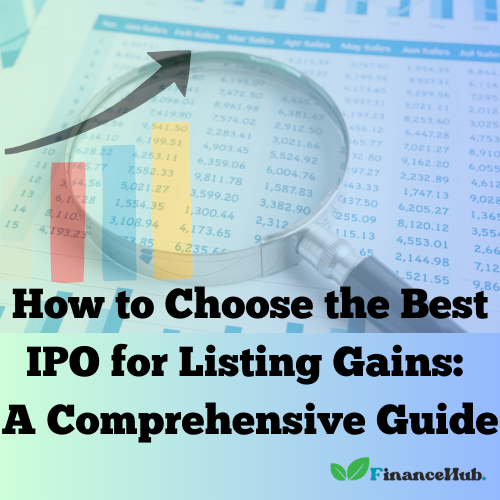Investing in Initial Public Offerings (IPOs) can be highly rewarding, especially if you aim for listing gains—the profit earned when a stock lists at a price higher than its issue price. However, not all IPOs perform well, and some may even list at a discount.
In this Article we’ll explore:
✅ Key factors to evaluate before investing in an IPO
✅ How to identify high-potential IPOs for listing gains
✅ Risks involved and how to mitigate them
✅ Real-world examples of best & worst-performing IPOs
Let’s dive in!
1. Understanding Listing Gains in IPOs
Listing gain refers to the profit an investor makes when an IPO lists at a price higher than its issue price. For example:
- Vibhor Steel Tubes Ltd. (2024 IPO) had an issue price of ₹151 but listed at ₹425—a 181.46% listing gain1.
- Winsol Engineers Ltd. (SME IPO 2024) surged 386.67% on listing day1.
However, not all IPOs perform well. Some, like R K Swamy Ltd. (2024), listed at a 13.19% discount1.
Why Do Some IPOs Give High Listing Gains?
- Strong demand (high subscription)
- Positive grey market premium (GMP)
- Solid financials & growth prospects
- Favorable market sentiment
2. Key Factors to Evaluate Before Investing in an IPO
A. Company Fundamentals
Before investing, check:
✔ Revenue & Profit Growth – Consistent growth in sales and net profit is a positive sign.
✔ Debt Levels – High debt can be risky.
✔ Return on Equity (RoE) – A high RoE (above 15%) indicates efficient capital use.
Example: Bajaj Housing Finance Ltd. (2024 IPO) had strong financials, leading to a 114.29% listing gain1.
B. Industry & Sector Trends
- High-growth sectors (e.g., AI, renewable energy, fintech) tend to attract more investor interest.
- Regulatory risks (e.g., solar energy companies facing policy changes).
Example: BLS E-Services Ltd. (IT sector) gained 125.93% on listing1.
C. IPO Valuation (P/E Ratio, P/B Ratio)
- Compare the IPO’s P/E ratio with industry peers.
- Avoid overvalued IPOs (e.g., P/E > 50 when industry average is 30).
Example: Clean Science and Technology Ltd. (2021 IPO) had a P/E of 48.18 but still delivered strong returns3.
D. Subscription Rate & Investor Interest
- Retail vs. QIB (Qualified Institutional Buyers) Subscription – High QIB interest is a good sign.
- Oversubscription – Indicates strong demand.
Example: Tata Technologies Ltd. (2023 IPO) was oversubscribed 69.43x, leading to a 162.60% listing gain9.
E. Grey Market Premium (GMP)
- GMP is the unofficial premium at which IPO shares trade before listing.
- A high GMP suggests strong listing gains.
Example: Sigachi Industries Ltd. (2021 IPO) had a 267.18% listing gain, partly due to high GMP9.
F. Promoter & Management Quality
- Check the track record of promoters.
- Look for institutional backing (PE/VC investments).
Example: Gland Pharma Ltd. (backed by KKR) had a successful IPO3.
G. Market Sentiment & Economic Conditions
- Bull markets favor IPO gains.
- High-interest rate environments may reduce IPO demand.
Example: The 2024 IPO market saw strong gains due to declining interest rates2.
3. How to Apply for an IPO for Maximum Gains?
A. Apply via ASBA (Bank Account) or Broker
- Use UPI for faster applications.
- Avoid last-minute rush—apply early.
B. Bid at the Cut-Off Price
- Ensures allotment at the lowest possible price.
C. Check Allotment Status & Exit Strategy
- If allotted, decide whether to hold or sell on listing day.
- If not allotted, track grey market trends before buying post-listing.
4. Risks of Investing in IPOs for Listing Gains
❌ Overvaluation Risk – Some IPOs list high but crash later (e.g., Medicamen Organics Ltd. fell 60% post-listing)1.
❌ Market Volatility – Geopolitical events can impact listings8.
❌ Liquidity Crunch – SME IPOs may have low trading volumes.
How to Mitigate Risks?
✔ Avoid FOMO (Fear of Missing Out) – Not every IPO is worth it.
✔ Diversify – Don’t put all funds into one IPO.
✔ Set Stop-Loss – Exit if the stock falls below a threshold.
5. Case Studies: Best & Worst IPOs for Listing Gains
Best Performing IPOs (2024)
| Company | Issue Price (₹) | Listing Price (₹) | Gain (%) | |
| Vibhor Steel Tubes | 151 | 425 | 181.46% | |
| Mamata Machinery | 243 | 600 | 146.91% | |
| BLS E-Services | 135 | 305 | 125.93% | |
| Winsol Engineers (SME) | 75 | 365 | 386.67% | |
| Kay Cee Energy (SME) | 54 | 252 | 366.67% | 1 |
Worst Performing IPOs (2024)
| Company | Issue Price (₹) | Listing Price (₹) | Loss (%) | |
| R K Swamy Ltd. | 288 | 250 | -13.19% | |
| ACME Solar | 289 | 251 | -13.15% | |
| Godavari Biorefineries | 352 | 308 | -12.5% | 1 |
6. IPO Market Outlook for 2025
- More tech & AI-based IPOs (e.g., CoreWeave, Klarna)8.
- Private equity-backed IPOs may rise due to pent-up demand12.
- SME IPOs continue to outperform in listing gains1.
7. Final Checklist Before Investing in an IPO
✅ Strong financials (Revenue, Profit, Low Debt)
✅ Reasonable valuation (P/E, P/B vs. peers)
✅ High subscription & institutional interest
✅ Positive grey market premium (GMP)
✅ Favorable sector trends
✅ Experienced management
Conclusion: Should You Invest in IPOs for Listing Gains?
Yes, but selectively.
- Short-term traders can profit from listing pops.
- Long-term investors should focus on fundamentals.
Pro Tip: Track upcoming IPOs on platforms like Chittorgarh, IPOPlatform, or Groww13.
By following this guide, you can maximize IPO gains while minimizing risks. Happy investing! 🚀

Sekhar Gour is the creator of Finance Hub Assam. A finance enthusiast with a knack for simplifying complex money matters, Sekhar offers practical insights tailored to Assam’s economic scene. When not writing, he enjoys exploring local culture and market trends.

